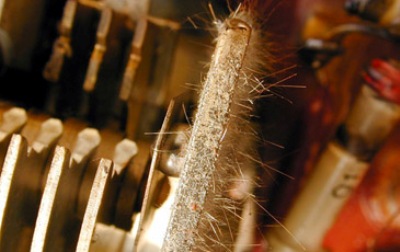Dec 5 2012
Americans love their electronics, and millions will undoubtedly receive everything from flat-screen TVs and e-readers to video games and coffee makers this holiday season. Over time, even the best of these devices inexplicably stop working. Often it’s not worth the time and money to have them repaired, but the nagging question of “why” still lingers long after they’re thrown in the trash.
 Tin whiskers growing on an electronic circuit.
Tin whiskers growing on an electronic circuit.
Yong Sun, a mechanical engineering doctoral student at the University of South Carolina’s College of Engineering and Computing, has solved part of the puzzle.
Little-known culprits, tiny killers that leave no evidence the human eye can detect, of this electronic destruction are microscopic strands known as “whiskers.” These hair-like fibers of metal grow out of the tin used as solder and coating on many electronic circuits. The presence of these whiskers can cause short-circuits since they act as bridges to conduct electricity to closely-spaced parts, a problem expected to become more prevalent as devices are designed smaller and smaller.
The whisker phenomena have been known within scientific circles since the 1940s, but just how these tin whiskers form and grow was largely a mystery. He used a process called digital image correlation to track the deformation of the surfaces and was able to prove the growth of whiskers are caused by high-strain gradient built up inside the device.
Sun’s findings were published in the Scripta Materialia, a materials science journal. This fall he won the prestigious Acta Student Award, one of only six to receive the honor. A team of editors from Acta Materials, Scripta Materialia and Acta Biomaterials evaluated the applications and Sun beat out students from the world’s top universities, including MIT.
“This shows that our research in material science is reaching an international audience,” Sun said. “It is nice to be recognized for our work.”
The importance of that work goes well beyond extending the operating life of consumer electronics. NASA has verified multiple commercial satellite failures it attributes to tin whiskers. Missile systems, nuclear power stations and heart pacemakers also have fallen victim to tin whiskers over the past several decades and they are also considered a suspect in reported brake failures in Toyota vehicles.
While manufactures had been able to control some whiskers by mixing small amounts of lead into tin solder, the 2006 European Union ban on lead in most electronic equipment had ignited a debate among scientists about whether whiskers would remain a perpetual problem. Some observers even predict that it’s only a matter of time before miniature devices built after the ban start failing en masse.
Xiaodong Li, a professor in USC’s Department of Mechanical Engineering who served as an adviser on the research, said Yong’s work likely will prompt manufacturer to design lead-free products that diffuse stress.
“This (research) is a very big deal. As we move toward nano-scale devices, this is a problem that needs to be solved,” Li said.